“BANG, ZOOM!” “You’re going to the moon!”
Those are two famous lines Ralph would jokingly say to his wife when she got on his nerves in the old show “The Honeymooners.”
But the phrases could also aptly have been attributed to a planet from long ago that crashed into Earth, thus forming our moon.
While this idea of an alien planet hitting Earth and forming our lunar friend has been discussed for years, there has not been enough evidence to mount a serious, proved case for it.
That is, until now.
Qian Yuan, a Ph.D. student at Arizona State University, believes there is enough evidence in the Earth’s crust to prove that it was an Earth-sized planet that crashed into our home, lodging foreign rocks in the mantle and jettisoning what would become our moon into space.
As reported in Science:
“Scientists have long agreed that the Moon formed when a protoplanet, called Theia, struck Earth in its infancy some 4.5 billion years ago. Now, a team of scientists has a provocative new proposal: Theia’s remains can be found in two continent-size layers of rock buried deep in Earth’s mantle.
“For decades, seismologists have puzzled over these two blobs, which sit below West Africa and the Pacific Ocean and straddle the core like a pair of headphones. Up to 1000 kilometers tall and several times that wide, ‘they are the largest thing in the Earth’s mantle,’ says Qian Yuan, a Ph.D. student in geodynamics at Arizona State University (ASU), Tempe. Seismic waves from earthquakes abruptly slow down when they pass through the layers, which suggests they are denser and chemically different from the surrounding mantle rock.”
The idea of such an impact could explain why there is no water on the moon. The force of the planet hitting Earth would have immediately burned up any water clinging on or inside the rocks that formed it.
Yuan’s idea is not concrete, however. There are other possibilities as to what the formations they are seeing in Earth’s mantle are.
“The large low-shear velocity provinces (LLSVPs), as seismologists call them, might simply have crystallized out of the depths of Earth’s primordial magma ocean. Or they might be dense puddles of primitive mantle rock that survived the trauma of the Moon-forming impact. But based on new isotopic evidence and modeling, Yuan believes the LLSVPs are the guts of the alien impactor itself. ‘This crazy idea is at least possible,’ says Yuan, who presented the hypothesis last week at the Lunar and Planetary Science Conference.”
To read the full story in Science, click here.
